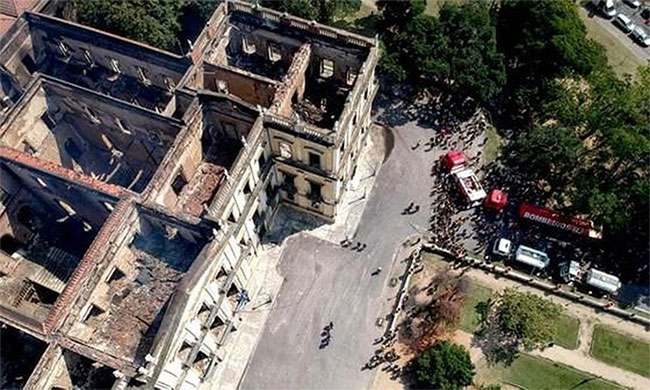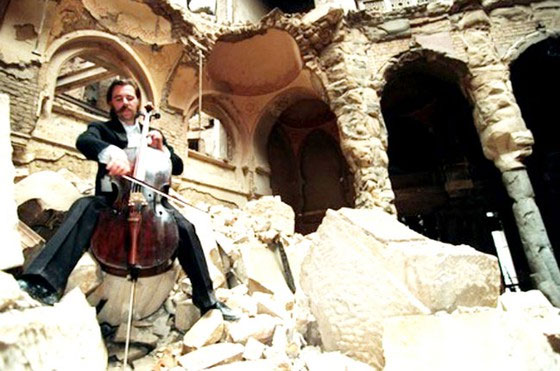The wonders of world heritage have disappeared forever
When a legacy is destroyed or naturally lost over time, it will leave a sense of regret.
National Museum of Rio de Janeiro, Brazil
On September 2, 2018, about 90% of collections with about 20 million artifacts from the National Museum of Rio de Janeiro were burned down by fire. This is the largest museum in Latin America and is also a historical monument. For experts, this disaster is a blow to the culture of Brazil.

The museum area is viewed from above.
Writing on his personal page, anthropologist Mercio Gomes is sad: 'Brazil has only 500 years of history. This national museum is 200 years old and some things are gone forever. ' And Museum Director Alexander Kellner said: 'The museum's collection is not only the history of Rio de Janeiro or Brazil, but also the foundation of world history.'
The fire destroyed countless valuable Brazilian artifacts such as dinosaur bones, ancient mummies, written records in the language of the extinct indigenous people, many artifacts of the Americas before the arrival. of Europeans and frescoes of the ancient Roman city of Pompeii. So far, the cause of the fire is attributed to a small balloon that landed on the roof of this museum, or a short circuit in the audiovisual room.
Sarajevo Library, Bosnia

Sarajevo Library (Bosnia) after being destroyed.
The National Library of Sarajevo of Bosnia, built in 1896, is home to around 2 million books and ancient bibliographies, burned in a fire caused by Serbian gunmen shells at night. August 25, 1992.
Bosnia experienced a war from 1992 to 1995. Only 10% of library materials, or about 300,000 books in over 2 million rare books, were saved. The reconstruction of this ruined building began in 1996 and was partially funded by the European Union. The new library was inaugurated in 2014.
The largest Buddha image in the world, Afghanistan

These are 2 of 3 Buddha statues built from the 4th to 8th centuries.
18 years have passed since the destruction of the two Bamiyan Buddha statues, there have been many upheavals in Afghanistan, but for Buddhists, the obsession with that incident has not been overshadowed.
Despite the opposition and outrage of the whole world, two 55m and 37m high Buddha statues, carved into sandstone mountains from the 6th century in Bamiyan province, were blown up by the Taliban in 2001. Initially, Taliban forces destroyed the statues with tanks and mortars. But unsuccessfully, they placed explosive blocks to destroy it. These are two of the three Buddha statues built between the 4th and 8th centuries, making Bamiyan a holy place of Buddhism. Located on the Silk Road, 3 monumental statues witness the passing of merchants and pilgrims, the emergence of Islam in the region in the 9th century .
After the fall of the Taliban, historians and archeologists have repeatedly debated whether to recover and whether it is worth recovering. According to UNESCO, it is difficult to recover 2 Buddha statues because many pieces have been completely destroyed. However, the Afghan Government built the Museum in Bamiyan to display these debris and valuable relics to show people the tragic history of the Buddhas in Bamiyan.
Palmyra Citadel, Syria

Palmyra Citadel.
On January 20, 2017, the self-proclaimed Islamic State organization (IS) used explosives to completely destroy the face of the ancient Roman Theater built in the 2nd century and the Tetrapylon architecture. The most famous cube in the citadel of Palmyra.
In fact, the ancient citadel of Palmyra in central Syria was destroyed many times during the period of ISIS occupation and was repelled. During the 2015 invasion of the city, IS destroyed key temples and thousands of monuments in Palmyra, including temples, tombs, and other non-religious ruins . When government forces lost a city again in December 2016, jihadists used four-column cluster explosives, damaging the Roman theater. On January 22, 2017, Syrian Culture Minister Muhammad Ahmad condemned the demolition aimed at heritage and culture as a 'war crime'.
The tower of Nanjing, China
Built in the 15th century during the Ming Dynasty, Luu Ly Tower is a Buddhist religious site in Nanjing, China. The tower was allowed to be built in 1412 by King Minh Thanh To, effective Vinh Lac and took 17 years to complete. This tower is located in Bao An Tu temple complex and has been considered one of the 'Seven Wonders of the Middle World'.

The Tower is restored today.
Luu Ly tower is not the tallest (Liao Liao Tower in Hebei is as high as 84m), but deserves to be the most beautiful tower. The name Liu Li originated from the borage bricks (white porcelain bricks) used to erect this tower. During the day, the sunlight shines on the bricks, making the tower sparkle.
At night, about 140 porcelain lanterns lit the tower together. In 1801, the tower was struck by lightning and partially damaged. In 1853, the Taiping Kingdom, the rebellion army at the time, captured Nanjing. By 1856, they completely destroyed this tower, the purpose of preventing the enemy from taking advantage of the tower to observe, or because of a conflict of beliefs. In 2010, businessman Wang Jianlin provided 1 billion yuan (about US $ 150 million) in aid to rebuild the tower.
Great Library of Alexandria, Egypt
Alexandria was built by King Alexander the Great in 331 BC after conquering Egypt. After the death of King Alexander the Great, one of his generals, General Ptolemy, set up a new dynasty that lasted for hundreds of years. During the reign of the First Egyptian King Ptolemy, the whole Alexandria area became the center of education and a huge library was built to hold hundreds of thousands of documents, stored as 700,000 papyrus scrolls. and other Sumerian clay pellets.

In 48 BC, the entire library was destroyed and became a tragedy of history.
This is considered the collection as the basis for many scientific and theological works. By the 7th century, many people came here to study and teach. However, by 48 BC, the entire library was destroyed and became a tragedy of history. The fact that the Great Library of Alexandria of Egypt was burned is an event of devastating destruction to human knowledge.
However, many library documents still exist after the mysterious destruction. By the year 604, as Islam developed and the area was conquered by the Arab army of General Caliph Omar, he ordered the destruction of all books here. After this destruction, historians all agreed that all the great knowledge here had disappeared.
Nalanda Buddhist University
Nalanda (now in northeastern India) was one of the first universities in the world and the largest Buddhist university in history. This architectural masterpiece was established in the 5th century and stretches over 14ha. From the 5th to 12th centuries, the University of Nalanda is an excellent academic center and one of the oldest universities in the world.

Ruins of Nalanda University after devastation.
At the height of its glory, Nalanda is home to 2,000 teachers and over 10,000 students from South Korea, Japan, China, Tibet, Indonesia, Persia and Turkey. Many famous Buddhist scholars have come to study here, including two famous Chinese monks, Phap Hien and Huyen Trang. However, the University of Nalanda was destroyed by Islamic invaders in 1193.
In an attempt to restore Nalanda University's reputation and monuments, in 1951, an elite Buddhist scholar, Jagdish Kashyap, founded an intensive research center on Pali and Buddhism in the nearby next to the original relics. The center, called Nava Nalanda Mahavihara, still exists today. In September 2014, Nalanda University, a global model of research and teaching center, was officially opened in the Buddhist pilgrim town of Rajgir in the state of Bihar, India.
Great library of Baghdad
On January 20, 1258, the Hulegu Khan army, one of the grandsons of Genghis Khan (Mongolia), arrived at the gate of Baghdad, the capital of the Abbasid Caliphate empire. This city is one of the most advanced cities in the world and is one of the most populous cities.

The old city of Badhdad.
The Hulegu Khan army surrounded the city and captured it in less than 3 weeks. The massacres have killed at least 200,000 people, while mosques, palaces and the Great Library have been razed .
The great library of Baghdad, founded in the 9th century, is home to countless scientific, astronomical, medical and philosophical works. It can be said that this is the archaeological storage area of the most important type of the whole Middle East.
- The world has 4 more natural heritages
- Compare 7 world wonders in ancient and modern times
- Okavango Plain - World Natural Heritage in Botswana
- 7 Wonders of the World ... computers
- The appearance of 7 new and old wonders of the world
- July 7: New7wonder organization announces the New Seven Wonders of the World
- Da Tuc stone carvings
- Inca trail
- 7 new wonders of the world
- 8 mysterious ancient wonders of the world yet to name
- Di Hoa Vien - World Cultural Heritage in China
- Secrets - World Cultural Heritage in China
 'Fine laughs' - Scary and painful torture in ancient times
'Fine laughs' - Scary and painful torture in ancient times The sequence of numbers 142857 of the Egyptian pyramids is known as the strangest number in the world - Why?
The sequence of numbers 142857 of the Egyptian pyramids is known as the strangest number in the world - Why? History of the iron
History of the iron What is alum?
What is alum?